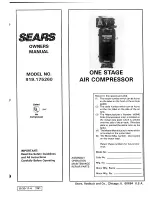
13–10–613 SP Page 1
SECTION 1
GENERAL INFORMATION
FIGURE 1–1 – COMPRESSION CYCLE
COMPRESSOR – The Gardner Denver Electra–Saver
compressor is a single stage, positive displacement
rotary machine using meshing helical rotors to effect
compression. The input drive shaft and helical drive
gear are supported in the gear case by high capacity
tapered roller bearings. The drive gear meshes with a
driven gear mounted on the main rotor shaft to drive the
rotors. Both rotors are supported between large capac-
ity anti–friction bearings located outside the compres-
sion chamber. Single width cylindrical roller bearings
are used at the inlet end of the rotors. Early models
used two (2) heavy–duty, single–row, angular contact
ball bearings at the discharge end to locate each rotor
axially and carry all thrust loads; later models use ta-
pered roller bearings in this location.
COMPRESSION PRINCIPLE (FIGURE 1–1) – Com-
pression is accomplished by the main and secondary
rotors synchronously meshing in a one–piece cylinder.
The main rotor has four (4) helical lobes 90
_
apart. The
secondary rotor has five (5) matching helical grooves
72
_
apart to allow meshing with main rotor lobes.
The air inlet port is located on top of the compressor
near the center. The discharge port is near the bottom
at the opposite end of the compressor cylinder. Figure
1–1 is an inverted view to show inlet and discharge
ports. The compression cycle begins as rotors unmesh
at the inlet port and air is drawn into the cavity between
the main rotor lobes and secondary rotor grooves (A).
When the rotors pass the inlet port cutoff, air is trapped
in the interlobe cavity and flows axially with the meshing
rotors (B). As meshing continues, more of the main ro-
tor lobe enters the secondary rotor groove, normal vol-
ume is reduced and pressure increases.
Oil is injected into the cylinder to remove the heat of
compression and seal internal clearances. Volume re-
duction and pressure increase continues until the air/oil
mixture trapped in the interlobe cavity by the rotors
passes the discharge port and is released to the oil res-
ervoir (C). Each rotor cavity follows the same “fill–com-
press–discharge” cycle in rapid succession to produce
a discharge air flow that is continuous, smooth and
shock free.
AIR FLOW (FIGURE 5–1, page 40) – Air enters the air
filter and passes through the inlet unloader valve to the
compressor. After compression, the air/oil mixture
passes into the oil reservoir where most of the en-
trained oil is removed by velocity change and impinge-
ment and drops back into the reservoir. The air and re-
maining oil then passes through the oil separator; the
separated oil is returned to the system through tubing
connecting the separator and compressor. The air
passes through the reservoir discharge manifold, dis-
charge check valve, minimum pressure valve and the
customer furnished unit shutoff globe valve to the plant
air lines.
LUBRICATION, COOLING AND SEALING – Oil is
forced by air pressure from the oil reservoir through the
oil cooler, thermostatic mixing valve, and oil filter and
discharges into the compressor main oil gallery. A por-
tion of the oil is directed through internal passages to
the bearings, gears and shaft oil seal. The balance of
the oil is injected directly into the compression chamber
to remove heat of compression, seal internal clear-
ances and lubricate the rotors.
TURN VALVE – The turn valve is a rotary helical valve
located on the discharge side of the cylinder toward the
inlet end. The valve opens and closes ports in the cylin-
der which communicates with the inlet passage. This
varies the compressor rotor volume to match the de-
mand for air, thus reducing the part–load power re-
quirement.
Summary of Contents for ELECTRA-SAVER EAYQ E
Page 15: ...13 10 613 SP Page 6 DECALS 206EAQ077 212EAQ077 218EAQ077 211EAQ077 207EAQ077 ...
Page 16: ...13 10 613 SP Page 7 DECALS 216EAQ077 217EAQ077 222EAQ077 221EAQ077 208EAQ077 ...
Page 31: ...13 10 613 SP Page 22 FIGURE 4 2 FLOW CHART FOR SET UP PROGRAMMING ...
Page 48: ...13 10 613 SP Page 39 FIGURE 4 13 WIRING DIAGRAM 202EAY546 Ref Drawing ...
Page 75: ......











































